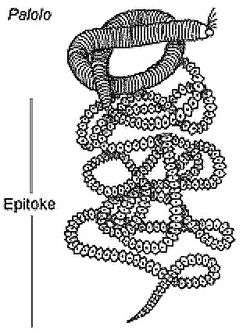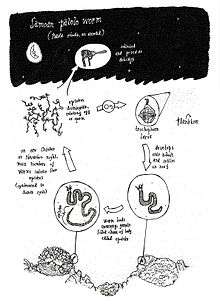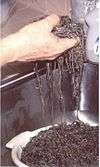Palolo worm
| Palolo worm | |
|---|---|
 | |
| Scientific classification | |
| Kingdom: | Animalia |
| Phylum: | Annelida |
| Class: | Polychaeta |
| Order: | Eunicida |
| Family: | Eunicidae |
| Genus: | Palola |
| Species: | P. viridis |
| Binomial name | |
| Palola viridis (Gray, 1840) | |
| Synonyms | |
|
Eunice viridis | |
The palolo worm or Samoan palolo worm (Palola viridis) is a Polychaeta species from the waters of the Pacific islands around Samoa.
Life cycle

Reproduction involves mass spawning at night in spring or early summer (October - November in the Southern Hemisphere). The terminal parts of their bodies drop off and float over the surface of the water, releasing sperm and eggs. The mechanisms or triggers which induce spawning such that it occurs during nights of a waning moon, continuing for several nights, are not completely known.[1]
Taxonomy
It is sometimes synonymous with Palola siciliensis.
Distribution
The palolo worm is found in various tropical regions, including in Indonesia, Vanuatu, Fiji, Samoa and American Samoa.
Cultural use

Indigenous populations in various parts of the Pacific – including Vanuatu and Samoa – use the reproductive portion of the palolo worm as a food source. During their short lived annual appearance in the last quarter of the moon in October and November, worms are enthusiastically gathered with a net, and are either eaten raw or cooked in several different manners.
In Indonesia, a traditional event called Bau Nyale are held between February and March in the Indonesian island called Pulau Lombok annually. The event focuses on catching these worms as bait or as a delicacy for the locals.
This event is so important to the inhabitants of the Torres and Banks Islands of Vanuatu that it is featured in their lunar calendar.[2]
Notes
- ↑ Craig, P. "Natural History Guide to American Samoa" (PDF). National Park of American Samoa, Department Marine and Wildlife Resources, American Samoa Community College. Retrieved 16 August 2009.
- ↑ Codrington (1891); Mondragón (2004).
References
- World Conservation Monitoring Centre 1996. Eunice viridis. 2006 IUCN Red List of Threatened Species. Downloaded on 5 August 2007.
- Codrington, Robert (1891). The Melanesians: Studies in their Anthropology and Folk-Lore. Oxford: Clarendon Press.
- Mondragón, Carlos (June 2004). "Of Winds, Worms and Mana: The Traditional Calendar of the Torres Islands, Vanuatu". Oceania. 74 (4): 289–308. JSTOR 40332069.
External links
- Image of the head of a palolo worm from the Smithsonian Institution
- Samoa Worm Sperm Spawns Annual Fiesta from National Geographic
- The Lunar Calendar of the Banks Islands
